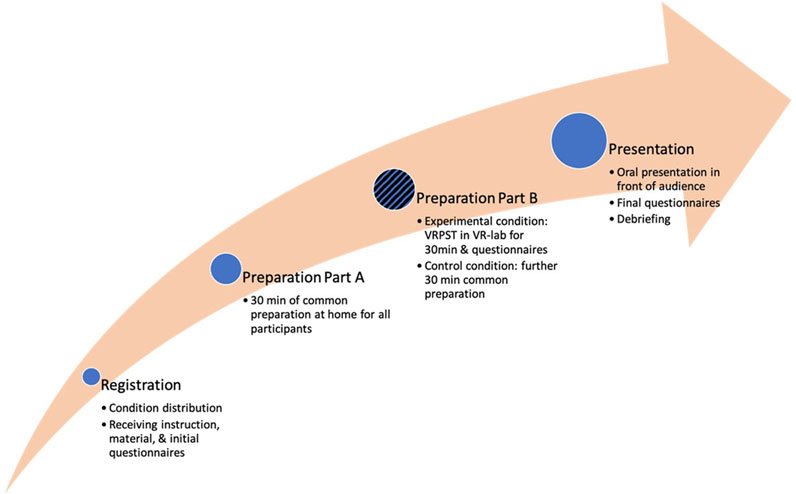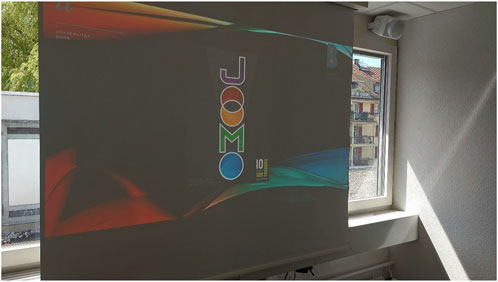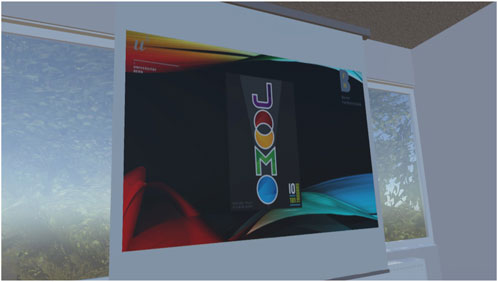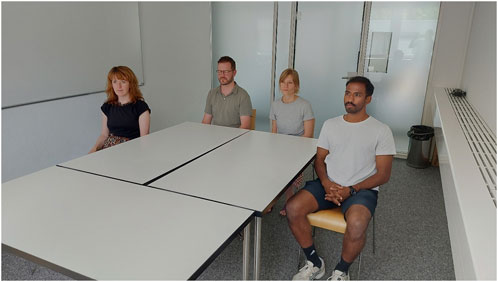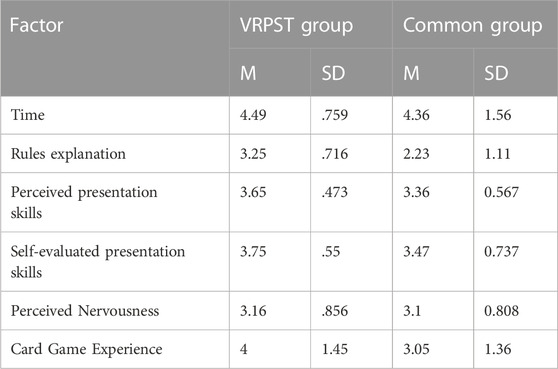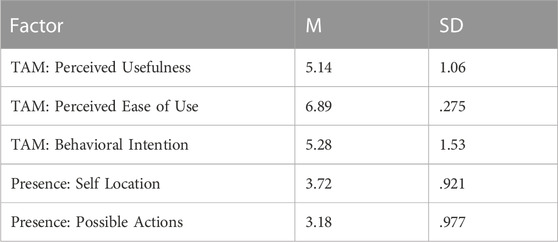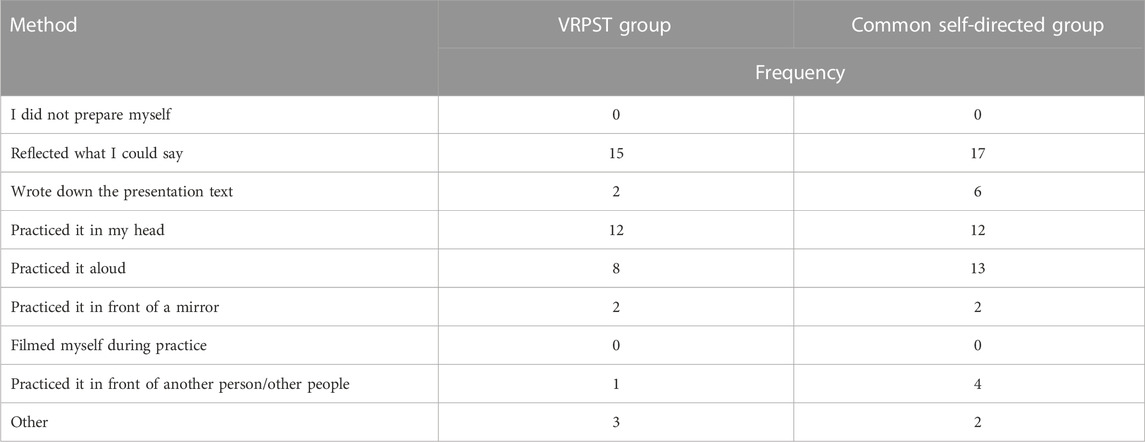- 1Department of Social Work, Institute for Specialized Didactics, Profession Development and Digitalization, Bern University of Applied Sciences, Bern, Switzerland
- 2Department of Psychology, University of Bern, Bern, Switzerland
Public speaking is a fundamental task in many professional or personal situations. At the same time, there is widespread fear of it, and it takes practice to present well. Previous studies suggest that Virtual Reality Public Speaking Training (VRPST) offers a promising opportunity for this. However, studies evaluating objective and subjective indicators are lacking so far, and valid control conditions are missing in previous studies. We aimed to overcome these drawbacks. In our experiment, participants (N = 42) had the task of presenting a card game to a four-person audience using five provided PowerPoint slides within a time limit of 5 minutes. They prepared either using VRPST or using common self-directed preparation (control condition), being randomly assigned to a condition. Both groups were instructed to prepare for the task at home and given 30 min to learn the rules of the game and present them using the slides. The control group was given an additional 30 min to prepare individually for the presentation task at home. The experimental group received an additional 30-min VRPST session. This training session was done without specific feedback and the presentation was repeated three times. The quality of the rule explanation, the audience-assessed presentation quality, and the subjects’ self-assessed presentation quality were measured. Our results indicate that the VRPST is effective. Subjects who completed the VRPST did a better job of explaining the rules and were better rated by the audience. In addition, the experimental subjects also tended to rate their presentation better in the VRPST condition. Further analyses of those participants who completed the VRPST show high technology acceptance. Our results show the VR training had a significant performance-enhancing effect and that participants would use the VRPST if it were available to them. It seems that practicing a presentation in VR is useful and even better than a conventional preparation.
1 Introduction
Presenting and speaking in front of an audience is a common and frequent task in various professional, educational, and personal contexts (Dunbar et al., 2006; Pathak and Le vasan, 2015). Thus, speaking in front of others is a basic skill: Students present their work in courses in front of fellow students, lecturers in front of students, teachers in front of pupils, or—e.g., in the context of a parents’ evening or an information event—in front of parents or other teachers. It is also common to have to present ideas to colleagues in a meeting, pitch projects to potential clients, or give a speech at a family gathering or a wedding.
However, for quite a few individuals, this activity poses a significant challenge that can even lead to public speaking anxiety. Fear of public speaking is widespread, with a prevalence of about 20 percent, which means that public speaking is the most frequent social anxiety (e.g., Furmark et al., 1999; Ruscio et al., 2008). But even for individuals who are not afraid of public speaking, performing confidently and competently in front of an audience can be challenging and requires practice. Various methods can be helpful to prepare and practice for public speaking (for an overview see Allen et al., 1989). One such approach, referred to as in sensu—also referred to as imaginal exposure (for an overview, see James, 1986) is to imagine the presentation situation and the audience in one’s mind and to rehearse it alone. Alternatively, exposure, i.e., practicing in front of a real audience (in vivo) may prove beneficial (e.g., Overholser, 2002). According to Overholser, controlled exposure allows individuals to experience public performance despite anxiety or discomfort. While in sensu training is not as effective as training in vivo (Wolpe, 1968; Hamm, 2009), training with a real audience has some drawbacks: It requires coordination of venues and appropriate audiences. Thus, the physical presence of a real audience is time-consuming and costly. It is not always possible to recruit people willing to listen to a presentation for practice purposes. Virtual reality public speaking training (VRPST) offers a potential solution by providing training in a virtual environment in front of a simulated audience that is permanently available (Anderson et al., 2005; Wallach et al., 2009). This has the advantage of training in front of an audience, except that this audience is virtual. In a systematic review, Wechsler et al. (2019) conclude that in vivo and virtual reality therapy achieve comparable effects in exposure therapies to reduce social phobias.
There are good reasons to use virtual reality training. Virtual reality (VR) can be defined as a computer-generated, simulated environment that visually mimics complex physical spaces in which users can immerse themselves in (e.g., Bainbridge, 2007; Schroeder, 2008). Such an environment surrounds a person who perceives himself as surrounded by, included in, and interacting with an environment that provides a continuous stream of stimuli (Blascovich et al., 2002). Virtual reality (VR) simulations offer an ecologically valid or realistic option for training (Schmid Mast et al., 2018). VR enables users to immerse themselves in a mediated world and experience it as if it were real (cf. Dobricki et al., 2021; Weber et al., 2021). Thus, speaking in front of a virtual audience may provide an experience that is close to or even like standing in front of a real audience. This makes VR closer to an in vivo than an in sensu training. Behavior in VR thus feels realistic (Blascovich et al., 2022) and VR provides users the possibility to practice repeatedly in a safe environment without facing negative consequences (e.g., Gasteiger et al., 2022). This in turn can increase self-esteem and self-efficacy (see Lee et al., 2021). Virtual human training programs provide the opportunity to experience difficult situations without supervision in a controlled environment, as they simulate differentiated interpersonal situations, thus allowing users to acquire new skills and apply them in real-life situations (Palmas et al., 2019). Research has indeed shown that individuals display similar patterns of behavior in virtual reality as they do in real-world situations, as evidenced by Bombari et al. (2015) or Weber et al. (2021). Slater et al. (2006a) further demonstrated that VR exhibits physiological responses comparable to a real-life situation. Therefore, we have chosen to employ virtual reality technology to train individuals in public speaking by using a virtual environment to recreate real speeches.
In our study, we aim to examine Virtual Reality Public Speaking Training (VRPST). This is a VR-based training application that allows users to give a speech in front of a virtual audience and rehearse it that way. There are various types of VRPST targeting different user groups. For instance, there are VRPST programs tailored to specific age groups, such as children (Sülter et al., 2022), high-school students (Valls-Ratés et al., 2022), or adults. Additionally, VRPST programs differ in terms of their intended objectives, tasks (e.g., presentation, lecture, explanation), and environments (e.g., boardrooms, large auditoriums, and classrooms; see (Takac et al., 2019). Furthermore, the size of the audience and their accompanying behaviors can be manipulated in VRPST programs (Pertaub et al., 2002).
Several studies have empirically examined VRPST (Poeschl, 2017; Palmas et al., 2019; Boetje and Ginkel, 2021; Valls-Ratés et al., 2022). The results are promising, as previous research suggests that VRPSTs are effective, at least under certain circumstances. In their review, Daniels et al. (2020) state that 13 out of 14 existing studies report positive outcomes. They conclude that VR is an effective training tool that is portable, cost-efficient, and convenient to use anywhere at any time. Furthermore, they point to the ability of VR to induce real-life emotions through immersion which contributes to the enhancement of public speaking skills. Thereby, various positive outcomes have been observed in previous studies: For example, Yadav et al. (2022) found presentation exercises in front of a virtual audience led to both higher self-reported confidence and deeper physiological arousal before public appearances. Furthermore, it has been shown that VRPST can reduce public speaking anxiety (Takac et al., 2019; Boetje and Ginkel, 2021; Sülter et al., 2022) and it enhances presentation skills (e.g., nonverbal behavior) (Takac et al., 2019; Boetje and Ginkel, 2021; Sülter et al., 2022).
It could be shown that VR training works especially when it includes computer-assisted feedback (Van Ginkel et al., 2020) and that VRPST can promote motivation (Buttussi and Chittaro, 2018) or self-efficacy (Zhou et al., 2021). Slater et al. (2006b) were able to show that speaking in front of a virtual audience caused significantly more anxiety in people with a related phobia than speaking in an empty room. This in turn shows that the situation is experienced as if the audience were real. Lucas et al. (2014) even suggested that VRPST is better than in vivo exposure for individuals with social phobia because a virtual audience is an ecologically valid situation, but one that eliminates appraisal anxiety. Palmas et al. (2021) point out, however, that technology acceptance is a relevant precondition for VRPST to work. Additionally, after VRPST participants rate their public speaking performance as being better. Furthermore, Boetje and Ginkel (2021) suggest that several trainings should be conducted. In our study, participants completed three training runs in a row in a single training session.
Taken together, the previous studies suggest that VR-based training has various positive effects such as enhanced presentation skills, reduced public speaking anxiety, higher motivation, higher self-confidence, and lower arousal. However, these studies lack a control group to compare VR with other types of training. Furthermore, individual aspects have been examined so far (e.g., self-report or performance only), but a comprehensive measurement with subjective and objective indices has not been applied.
1.1 Aim of the current study
As described above, the existing research on VRPST is promising. However, we contend that there is a lack of studies that combine the assessment of various indicators of performance quality (content as well as presentation skills), subjective data such as the presenter’s perceived confidence, as well as acceptance of VR as a training option. Moreover, to our knowledge, there are only a few studies in which VR training is followed by a real presentation in front of a real audience. Accordingly, our goal was to create such an ecologically valid scenario. In addition, we aimed to create a valid control condition. In previous studies, there was either no control condition at all (e.g., Wortwein et al., 2015; Poeschl, 2017; Daniels, 2021), or the control consisted of training in front of an audience but using a desktop application instead of VR (e.g., Zhou et al., 2021). We chose to compare VR training to the most common setting (see Joughin, 2007) a self-directed preparation of a presentation. To our knowledge, such a comparison condition has never been used before.
Thus, our study aims to achieve three objectives: First, we will investigate the mechanism behind VRPST by measuring presentation performance comprehensively with both, “soft factors” (i.e., perceived presentation skills) and “hard facts” (i.e., quality of the rules explanation). Second, to ensure high external validity, we will compare VRPST with a common preparation for a presentation. Third, we will examine the participants’ acceptance of VRPST to determine their willingness to use the technology in the future, based on the Technology Acceptance Model of Davis (1989). The model has been widely used in various technological innovations over the last 30 years and measures behavioral intention, i.e., whether individuals would use the technology if it were available to them. This behavioral intention is influenced by perceived ease of use and perceived usefulness.
Our research question is the following: Does VRPST lead to a (objectively and subjectively) better performance compared to common self-directed preparation? Existing literature suggests that VR offers an excellent way to prepare for a presentation Accordingly, most findings reveal positive effects (cf. Daniels et al., 2020). We thus expect that VRPST will be more effective compared to the control condition (common self-directed preparation) in terms of rules explanation (Hypothesis 1) as well as in terms of perceived presentation skills (Hypothesis 2). Furthermore, we expect that the participants in the VR condition rate their performance as being better than those in the control condition (Hypothesis 3). In addition, we expect high technology acceptance ratings for our VRPST.
2 Materials and methods
2.1 Participants
A total of 44 participants took part in the study, of whom 42 completed the entire study (age: M = 22.90, SD = 6.10). Twenty-six participants were women, 15 were men, and 1 person identified himself as “other”. Most participants (97%) were students and received course credit in exchange for their participation. The remaining participants did not receive any compensation. Participants were treated following the Code of Ethics of the World Medical Association (Association, 1964) (Declaration of Helsinki), and the study was approved by the local Ethics Committee.
2.2 Design and procedure
The present study employed a between-subject design in which the mode of preparation for a presentation was manipulated. The independent variable mode of preparation had two levels. Thus, there were two conditions: Participants prepared themselves for a presentation either with a VRPST (experimental group, n = 20) or by common self-directed means (control group, n = 22). Participants were randomly assigned to one of the two groups upon recruitment (see Figure 1).
After signing up for the experiment, they initially completed a sociodemographic questionnaire and an informed consent form. All participants were then given written instructions that they would give a presentation explaining the rules of a card game called Joomo (Palm and Zach, 2022) using five PowerPoint (Figure 2) slides within a time limit of 5 minutes. Both groups were further instructed to prepare for the task at home and were given 30 min to learn the rules of the game and present them using the slides. The experimental group received an additional 30-min VRPST session (see Figures 3, 4) without specific feedback and completed an acceptance questionnaire afterward. The control group was given another 30 min to prepare for the presentation task individually at home. Both groups then delivered their presentations in front of a live audience consisting of four people (Figure 5) and completed questionnaires before and after the presentations concerning their sense of preparation and the subjective quality of their performance. Furthermore, the members of the audience rated the presentations in terms of the perceived presentation skills, and the rules explanation was captured. After the study, all participants received a debriefing about the aim of the study as well as the study design.
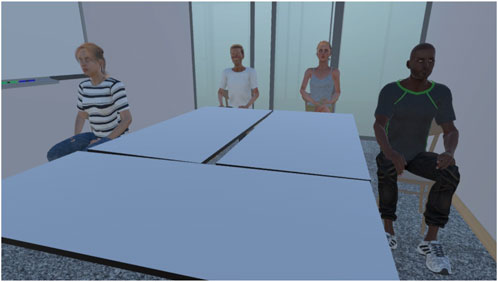
FIGURE 4. Virtual audience in the VRPST. Created with Unity Editor®. Unity is a trademark or registered trademark of Unity Technologies.
2.3 Materials
2.3.1 Measurement instruments
We administered all questionnaires using Unipark (Tivian XI GmbH, 2021).
Rules explanation. The task of the participants was to provide an explanation of the Joomo (Palm and Zach, 2022) card game (see 2.4.2 below) in a short presentation. To evaluate their objective performance in this task, we developed a set of five items. These items were referred to as “hard facts” as they refer to the rules of the game, which are crucial to playing Joomo. Participants were required to recall and present these rules accurately. For instance, one of these items involved the participant explaining the rationale behind the different colors of the cards. If the participant was able to satisfactorily explain this aspect, he or she was awarded one point. Similarly, an additional point was awarded for explaining the function of a particular special card. There were five items in total, as such the maximum possible score was five points.
Perceived presentation skills. The persons who constituted the audience simultaneously judged the presentations given. There was always a group of 4 people (at least one female) present during the presentations. Some of the raters were present in the VRPST of certain participants. Thus, they were not blind to the experimental condition and their ratings were excluded from the analysis for the participants they supervised during the VRPST. Therefore, 14 participants in the experimental group had 3 valid ratings each while the remaining 6 had 4 valid ratings each, and the participants from the control group all had 4 valid ratings each.
The raters rated four criteria (structure of presentation, fluency of speech, body posture of the presenting person, and voice quality, α = .75) as well as the perceived nervousness on a 5-point Likert scale (e.g., “Rate the presentation based on the fluency of speech.“, 1 = “bad”, 5 = “good”). The items were developed and used in a previous study and were thereby found to be a valid measure (Latu et al., 2013). Furthermore, the overall quality of the presentation was evaluated on a 6-point Likert scale analogous to the Swiss grading system from 1 (“miserable”) to 6 (“perfect”). Raters discussed before the presentations, to have the same understanding of the items. High interrater reliability resulted: Intraclass correlation (ICC) was .885 with a 95% confidence interval ranging from .814 to .933.
Self-evaluated presentation skills. The subjects evaluated their performance directly after the presentation. In line with (Latu et al., 2013), the same items were used as for the perceived presentation skills. Thus, they rated the structure of the presentation, the fluency of their speech, their body posture, and their voice quality on a 5-point Likert scale, and the overall quality of the presentation on a 6-point Likert scale. Reliability was acceptable with Cronbach’s’ alpha α = .69.
Duration of the speeches. The experimenter kept track of the duration of the participants’ presentations with a timer, starting with the first word spoken until the last word of the presentation. The length was measured in seconds. The task was not to exceed the given 5 minutes.
Knowledge of the game Joomo and card game experience. With two items, we also controlled if the participants had already known the game before taking part in the study and how often they played card-/board-games. The item to game knowledge they rated with “No”, “I’d heard of it”, and “I’d played it”, and of playing they rated on a 6-point Likert scale from 1 (“Never”) to 6 (“Often”).
Mode of preparation. The participants also reported how they prepared for the presentation other than with VRPST. We provided the participants with 8 items (cf. Table 3 below, e.g., “I talked it through in my head” and “I filmed myself while presenting”), and they were allowed to choose multiple alternatives and add other methods of preparation in an open question.
Technology acceptance. We measured technology acceptance based on Davis’ technology acceptance model TAM, (Davis, 1989; Davis et al., 1989). Only participants in the experimental condition or participants in the VRPST answered these questions. According to this model, technology acceptance consists of the three constructs perceived usefulness, perceived ease of use, and behavioral intention. A questionnaire to measure these items was developed by (Venkatesh and Davis, 1996; Venkatesh and Bala, 2008) and later refined by Venkatesh and Bala (2008). The model as well as the measurement were frequently used in the past and the latter was found to be a valid measure in various studies and contexts (cf. Silva, 2015). To measure perceived ease of use and behavioral intention we translated the items of this scale into German and adapted them for the VRPST. To measure perceived usefulness we used items in German developed by Scharfenberger (2012). In this way, we assessed three constructs: Perceived usefulness (7 items; 7-point Likert scale; example item: Computer-based methods such as VR technology are a good preparation for a presentation., α = .90), perceived ease of use (3 items1; 7-point Likert-scale; example item: I find it easy to get the VR system to do what I want it to do., α = .90) and behavioral intention (2 items; 7-point Likert-scale; example item: Assuming I had access to the system, I intend to use it., α = .81).
Presence in VR. For participants in the experimental group (VRPST), we further measured presence with the 8-item spatial presence experience scale by Hartmann et al. (2016) and assessed the two factors of self-location (4 items, e.g., “it felt as if I was really in the virtual reality”, α = .85) and possible actions (4 items, e.g., “I had the feeling that I could be active in the space of the virtual reality”, α = .78) on a 5-point Likert-scale with 4 items for each factor. The scale was carefully validated by Hartmann et al. (2016) and has been used in several previous studies (e.g., Daassi and Debbabi, 2021; Barreda-Ángeles and Hartmann, 2022).
2.3.2 Presentation task
Participants were required to present how to play the card game Joomo (Palm and Zach, 2022). The game was chosen because it was explainable based on its complexity in 5 min and because it was relatively unknown at the time. Getting started with the game is quick, and the gameplay concept is easy to understand. Players place cards into specific gaps. Joomo only uses numbers from 0 to 69. The game continues for multiple rounds. The goal of the game is for a player to reach 20 points. Based on the instructions 5 presentation slides (Figures 2, 6) were prepared and were not allowed to be altered by the participants.
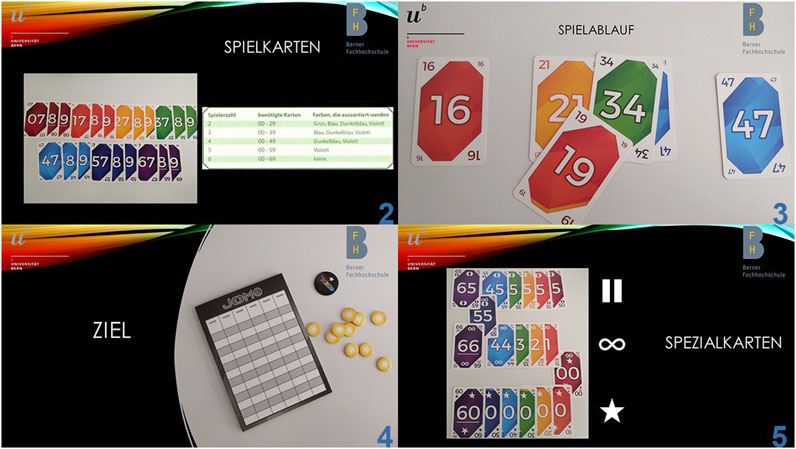
FIGURE 6. Slide 2 clarifies the composition of the playing cards (Spielkarten), followed by slide 3 which outlines the game’s sequential progression (Spielablauf). Slide 4 explicates the goal of the game (Ziel), while slide 5 offers an explanation of the playing cards and the unique special cards (Spielkarten). The slides are based on the official game rules. Reproduced with permission.
2.3.3 VR settings
For the study, the HTC Vive was used in conjunction with a computer with an Intel® Core™ i7-7700HQ CPU running at 3.8 GHz, 16.0 GB RAM, and an NVIDIA GeForce® GTX 1070 with 8 GB GDDR5 graphics unit. The VR scenario was designed using the Unity gaming engine in editor version 2021.3.8f1.
The avatars were designed with the Character Creator software version 3.44. The participant’s task was to explain the game using five PowerPoint slides (Figure 3). The virtual space was designed to resemble the room where the subsequent actual presentations took place. Four avatars were present in the virtual space, sitting on their chairs in an idle position (Figure 4). The distribution of avatars on the seats was randomized. The participants controlled the five PowerPoint slides (Figure 3) in the virtual environment using a Bluetooth device.
2.3.4 Statistical analysis
The analysis was conducted in the open-source statistical software program R (Version 4.2.2; R Core Team, 2018). ICC was calculated using the irrNA package (v0.2.3) to test for interrater reliability between raters of perceived presentation skills. One-tailed t-tests were calculated to test for differences between common self-directed preparation and VRPST preparation in terms of rules explanation, perceived presentation skills, self-evaluated performance, and control variables. A two-tailed ANOVA was performed to test if TAM influenced presentation performance in the VRPST group.
Post-hoc, two-tailed 2x3 ANOVA was performed to see if differences between groups were due to card game experience. We performed these analyses because the card game experience was different in the experimental and control conditions. These analyses allowed us to examine whether this confounding may have affected the results.
3 Results
3.1 Descriptives
The descriptive statistics for all variables measured for all participants are summarized in Table 1. The descriptive statistics for the variables TAM and presence, which were only measured in the experimental group (VRPST group), are summarized in Table 2.
None of the participants had reported having even heard of the game Joomo (Palm and Zach, 2022) before they received the task. A two-tailed t-test showed significantly higher card game experience in the VRPST group than the common preparation group, t(40) = 2.199, p = .034. To test the influence of the game experience on the dependent variables, we performed additional analyses (see “Further analyses” below). Table 3 shows how the participants prepared for the presentation.
3.2 Hypothesis testing
Hypothesis 1 states that VRPST leads to better or more correct rule explanations compared to the common preparation method. In line with this hypothesis, a t-test showed significant differences between the groups in terms of rules explanation, with a large effect size found., t(40) = 3.51, p < .01, d = 1.08. Similarly, hypothesis 2 predicts that VRPST leads to better-perceived presentation skills compared to common self-directed preparation. In line with this hypothesis, a difference between the two groups resulted, t(40) = 2.16, p = .04; d = 0.55. Thereby, a medium effect size was observed. Thus, hypothesis H1 and hypothesis H2 could be verified. However, against our expectations, there was no significant difference found between the self-evaluation of the presentation between the two preparation groups, t(40) = 1.40, p = .08, d = 0.43. Hypothesis H3 is therefore not confirmed, even though a tendency towards our prediction and a medium effect size could be observed.
Furthermore, we assumed that the subjects of the VRPST group were assigned high acceptance values TAM (Davis, 1989). We were able to measure high scores on all three main factors as can be seen in Table 2.
3.3 Further analyses
As mentioned above, the card game experience was different in the experimental compared to the control condition. To test for influences of the differences in card games, we conducted some further analysis. In correspondence to the findings reported above, the ANOVA leads to a significant main effect of mode of preparation regarding rules explanation, F(1, 38) = 12.29, p < .01. However, card game experience did not show to have an influence, F(1, 38) = .65, p = .43. Furthermore, no interaction between mode of preparation and card game experience was found, F(1, 38) = .124, p = .73. Furthermore, a main effects of mode of preparation resulted concerning perceived presentation skills, F(1, 38) = 5.25, p = .03, as well as card game experience, F(1, 38) = 6.98 p = 0.01. However, there was no interaction between the mode of preparation and card game experience, F(1, 38) = .27, p = .61. The results suggest that there is no confounding. It seems that although the card game knowledge was different between the two groups, this did not affect the effect of the independent variable.
4 Discussion
Previous research suggests that speaking in front of an audience can be practiced in VR and can reduce anxiety. However, to the best of our knowledge, there has not been an ecologically valid study that examines the impact of VRPST on the quality of a real speech in front of a real audience and also includes a control group comparing VRPST with common preparation. Thus, the goal of our study was to overcome these drawbacks. Our subjects practiced a presentation in which they had to explain a card game, at home for 30 min. One group of participants was then given the opportunity to practice the presentation for 30 min in VR, while the control group had another 30 min of self-directed practice. We aimed to examine the effectiveness of the VRPST compared to a common preparation and whether VRPST is accepted by the users.
Our results reveal that VRPST works. Participants who received virtual training performed better than the control group. According to our hypothesis, this applies to both the hard facts such as rules explanation as well as the soft facts such as the perceived presentation skills: The Participants with VRPST had explained the rules more comprehensively, and they were also perceived by the (blind) audience as more competent, i.e., less nervous, more fluent, and better structured. Also, the overall rating of the quality of the presentation was higher for participants in the experimental condition. Thus, the VR training had a clear performance improvement effect. This is in line with various previous studies (e.g., Poeschl, 2017; Palmas et al., 2019; Boetje and Ginkel, 2021; Valls-Ratés et al., 2022). These have also largely shown positive effects and demonstrated the benefits of training in VR. However, we think our study more clearly shows that VR has an advantage over other methods of preparation, as we compared the scores to a control condition. Further, our result has higher ecological validity compared to previous findings and is more generalizable to the real world, as we collected performance in a real presentation in front of a real audience. Moreover, previous studies have assumed that VR must be used multiple times over time to exert a positive effect (e.g., Boetje and Ginkel, 2021). According to our results, however, this is not the case. In contrast to most of the existing research, there was no need for multiple trainings over a long period. In our study, the positive effect could be produced in a single training session with three runs.
However, no significant difference was observed in the self-report data. Even though a tendency was observed, participants themselves did not rate their performance better after having received the VRPST. Thus, our third hypothesis was not supported. Why did the two groups (VRPST and control) not differ in this regard? One explanation could be that neither group received feedback from real audiences. The four raters were instructed not to express anything. In other words, the participants did not receive a direct reaction to their performance. A second reason why there was no difference in self-reporting could be that everyone was under stress. They did not know the audience (four raters), were not allowed to use notes, and had time pressure (5-min limit). However, this is a speculation, since we did not assess the stress level in the participants.
We expected that subjects of the VRPST group would assign high acceptance values to the VRPST. There are no benchmarks for the three constructs in the literature. However, it can be noted that the values are all high when the resulting mean is compared to the 7-point scale (High >4, Neutral = 4, and Low <4); (e.g., Jaradat and Al-Mashaqba, 2014). In our measurement, the values of the factors perceived usefulness and ease of use were above 5. For the factor behavioral intention, the mean value of 6.89 almost reached the maximum of 7. This indicates that participants would use VRPST if it were available to them. The high scores are also likely since the subjects voluntarily enrolled in this VRPST study. We assume that the subjects already have an openness and an interest in VR technology. On the other hand, this also means that the VR training method as we have created it works. According to Palmas et al. (2021) this is the basis for a successful VRPST.
Presenting in front of an audience is a basic skill. In many professional but also private areas, it is elementary to be able to perform in front of a group of people. However, being confident in front of an audience needs practice, and it is not that easy to get meaningful training. The most effective training would be in vivo training in front of an audience (e.g., Hamm, 2009). However, organizing a practice audience is time-consuming and was only done by a few people in our study (4 people) in the control group (self-directed preparation). This may also be because in vivo preparation can already induce stress and appraisal anxiety, which in turn can be a hindrance for inexperienced presenters with social anxieties. VR, on the other hand, offers a safe environment in which you can practice in front of a (virtual) audience, but there is no social pressure and possible appraisal anxiety is eliminated because the people present are not real. Furthermore, no individuals have to be recruited, which in turn makes VRPST less complex. The added value in terms of objective performance shows that VRPST leads to better results than usual self-directed preparation, which - as our data shows - consists mainly of a reflection on what should be said, or running through the slides in one’s head, what comes close an in sensu preparation. We therefore recommend that VR as a training option should therefore be offered in contexts such as schools, and universities, but also in companies, and appropriate devices and VR training environments should be provided. A prerequisite for a functioning VRPST is—as previous studies have shown (e.g., Palmas et al. (2021)—that acceptance of the technology is given. This is the case for us, as the high values show. However, we cannot say how a VRPST with deeper acceptance works. Our test subjects were also students, who may generally have a higher affinity for new technologies.
Thus, the results found here are promising. It seems that practicing a presentation in VR is useful and even better than a conventional preparation. However, we still know too little about what brought about the effect. Was it the exposure to the virtual audience? It is conceivable that the experience of presenting something to an audience came close to an in vivo experience. One indication might be that the scores of the experimental group were even higher than those who practiced in front of a real audience in the Control group or those who practiced in front of a mirror. However, these were only four and two subjects, respectively. Although the difference in rules explanations was even significant, (23) = 1.87, p = .04, meanvrpst = 3.25, meancontrol = 2.40), these results must of course be taken with caution and cannot be generalized without further ado due to the small number of participants. Future studies could compare practicing in VR with practicing in front of a real audience and practicing in sensu (with an imagined audience). This would indicate whether a VRPST is closer in vivo or in sensu.
Further, the potential of VR has not yet been exploited in this study. Thus, subjects in the experimental condition only practiced in VR. However, there is still the possibility that the VR presentation is recorded and that the subjects can view their held presentation and thus further improve it. Future studies could include this aspect as well.
Data availability statement
The original contributions presented in the study are included in the article/Supplementary material, further inquiries can be directed to the corresponding author.
Ethics statement
The studies involving humans were approved by the Ethics Committee of the Faculty of Human Sciences, University of Bern (nr. 2022-10-01). The studies were conducted in accordance with the local legislation and institutional requirements. The participants provided their written informed consent to participate in this study. Written informed consent was obtained from the individual(s) for the publication of any potentially identifiable images or data included in this article.
Author contributions
MB and DW developed the idea for the study. The study was designed by MB, DW, JB, and AS. JB created the virtual environments. AS, DW, MB, and JB were responsible for the data analysis and inference. MB and DW wrote the manuscript with support from JB and AS. All authors contributed to the article and approved the submitted version.
Conflict of interest
The authors declare that the research was conducted in the absence of any commercial or financial relationships that could be construed as a potential conflict of interest.
Publisher’s note
All claims expressed in this article are solely those of the authors and do not necessarily represent those of their affiliated organizations, or those of the publisher, the editors and the reviewers. Any product that may be evaluated in this article, or claim that may be made by its manufacturer, is not guaranteed or endorsed by the publisher.
Footnotes
1The construct originally consisted of four items. However, internal consistency was low using all items (α = .55) and could be enhanced up to α = .90 when deleting one item (“Interacting with the system does not require a lot of my mental effort.“).
References
Allen, M., Hunter, J. E., and Donohue, W. A. (1989). Meta-analysis of self-report data on the effectiveness of public speaking anxiety treatment techniques. Commun. Educ. 38, 54–76. doi:10.1080/03634528909378740
Anderson, P. L., Zimand, E., Hodges, L. F., and Rothbaum, B. O. (2005). Cognitive behavioral therapy for public-speaking anxiety using virtual reality for exposure. Depress. anxiety 22 (3), 156–158. doi:10.1002/da.20090
Association, W. M. (1964). Code of Ethics of the world medical association: declaration of Helsinki. BMJ 2, 177. Helsinki, Finland: WMA; June 1964.
Bainbridge, W. S. (2007). The scientific research potential of virtual worlds. science 317 (5837), 472–476. doi:10.1126/science.1146930
Barreda-Ángeles, M., and Hartmann, T. (2022). Psychological benefits of using social virtual reality platforms during the covid-19 pandemic: the role of social and spatial presence. Comput. Hum. Behav. 127, 107047–107113. doi:10.1016/j.chb.2021.107047
Blascovich, J., Loomis, J., Beall, A. C., Swinth, K. R., Hoyt, C. L., and Bailenson, J. N. (2002). Target article: immersive virtual environment technology as a methodological tool for social psychology. Psychol. Inq. 13 (2), 103–124. doi:10.1207/s15327965pli1302_01
Boetje, J., and Ginkel, S. (2021). The added benefit of an extra practice session in virtual reality on the development of presentation skills: A randomized control trial. J. Comput. assisted Learn. 37 (1), 253–264. doi:10.1111/jcal.12484
Bombari, D., Schmid Mast, M., Canadas, E., and Bachmann, M. (2015). Studying social interactions through immersive virtual environment technology: virtues, pitfalls, and future challenges. Front. Psychol. 6, 869. doi:10.3389/fpsyg.2015.00869
Buttussi, F., and Chittaro, L. (2018). Effects of different types of virtual reality display on presence and learning in a safety training scenario. IEEE Trans. Vis. Comput. Graph. 24 (2), 1063–1076. doi:10.1109/TVCG.2017.2653117
Daassi, M., and Debbabi, S. (2021). Intention to reuse AR-based apps: the combined role of the sense of immersion, product presence and perceived realism. Inf. Manag. 58 (4), 103453. doi:10.1016/j.im.2021.103453
Daniels, M. M., Palaoag, T., and Daniels, M. (2020). Efficacy of virtual reality in reducing fear of public speaking: A systematic review. IOP Conf. Ser. Mater. Sci. Eng. 803 (1), 012003. doi:10.1088/1757-899X/803/1/012003
Daniels, M. M. (2021). Usability assessment of virtual reality as a training tool for oral presentation. IOP Conf. Ser. Mater. Sci. Eng. 1077 (1), 012047. doi:10.1088/1757-899X/1077/1/012047
Davis, F. D., Bagozzi, R. P., and Warshaw, P. R. (1989). User acceptance of computer technology: A comparison of two theoretical models. Manag. Sci. 35 (8), 982–1003. doi:10.1287/mnsc.35.8.982
Davis, F. D. (1989). Perceived usefulness, perceived ease of use, and user acceptance of information technology. MIS Q. 13 (3), 319–340. doi:10.2307/249008
Dobricki, M., Weibel, D., Angelini, L., Mugellini, E., and Mast, F. W. (2021). Locomotor illusions are generated by perceptual body-environment organization. PloS one 16 (5), e0251562. doi:10.1371/journal.pone.0251562
Dunbar, N. E., Brooks, C. F., and Kubicka-Miller, T. (2006). Oral communication skills in higher education: using a performance-based evaluation rubric to assess communication skills. Innov. High. Educ. 31 (2), 115–128. doi:10.1007/s10755-006-9012-x
Furmark, T., Tillfors, M., Everz, P. O., Marteinsdottir Gefvert, O., and Fredrikson, M. (1999). Social phobia in the general population: prevalence and sociodemographic profile. Soc. PSYCHIATRY PSYCHIATRIC Epidemiol. 34 (8), 416–424. doi:10.1007/s001270050163
Gasteiger, N., van der Veer, S. N., Wilson, P., and Dowding, D. (2022). How, for whom, and in which contexts or conditions augmented and virtual reality training works in upskilling health care workers: realist synthesis. JMIR serious games 10 (1), e31644. doi:10.2196/31644
Hamm, A. O. P. (2009). Specific phobias. Psychiatric Clin. N. Am. 32 (3), 577–591. doi:10.1016/j.psc.2009.05.008
Hartmann, T., Wirth, W., Schramm, H., Klimmt, C., Vorderer, P., Gysbers, A., et al. (2016). The spatial presence experience scale (SPES): A short self-report measure for diverse media settings. J. Media Psychol. 28, 1–15. doi:10.1027/1864-1105/a000137
James, J. E. (1986). Review of the relative efficacy of imaginal and in vivo flooding in the treatment of clinical fear. Behav. cognitive psychotherapy 14 (3), 183–191. doi:10.1017/S0141347300014725
Jaradat, M.-I., and Al-Mashaqba, A. (2014). Understanding the adoption and usage of mobile payment services by using TAM3. Int. J. Bus. Inf. Syst. 16, 271–296. doi:10.1504/IJBIS.2014.063768
Joughin, G. (2007). Student conceptions of oral presentations. Stud. High. Educ. (Dorchester-on-Thames) 32 (3), 323–336. doi:10.1080/03075070701346873
Latu, I. M., Mast, M. S., Lammers, J., and Bombari, D. (2013). Successful female leaders empower women's behavior in leadership tasks. J. Exp. Soc. Psychol. 49 (3), 444–448. doi:10.1016/j.jesp.2013.01.003
Lee, H.-W., Kim, S., and Uhm, J.-P. (2021). Social virtual reality (VR) involvement affects depression when social connectedness and self-esteem are low: A moderated mediation on well-being. Front. Psychol. 12, 753019. doi:10.3389/fpsyg.2021.753019
Lucas, G. M., Gratch, J., King, A., and Morency, L.-P. (2014). It’s only a computer: virtual humans increase willingness to disclose. Comput. Hum. Behav. 37, 94–100. doi:10.1016/j.chb.2014.04.043
Overholser, J. C. (2002). Cognitive-behavioral treatment of social phobia. J. Contemp. psychotherapy 32 (2-3), 125–144. doi:10.1023/A:1020534025102
Palmas, F., Cichor, J., Plecher, D. A., and Klinker, G. (2019). “Acceptance and effectiveness of a virtual reality public speaking training,” in Paper presented at the 2019 IEEE International Symposium on Mixed and Augmented Reality (ISMAR).
Palmas, F., Reinelt, R., Cichor, J. E., Plecher, D. A., and Klinker, G. (2021). “Virtual reality public speaking training: experimental evaluation of direct feedback technology acceptance,” in Paper presented at the 2021 IEEE Virtual Reality and 3D User Interfaces (VR).
Pathak, A., and Le vasan, M. (2015). Developing oral presentation competence in professional contexts: A design-based collaborative approach. Int. J. Eval. Res. Educ. 4 (4), 179. doi:10.11591/ijere.v4i4.4509
Pertaub, D.-P., Slater, M., and Barker, C. (2002). An experiment on public speaking anxiety in response to three different types of virtual audience. Presence teleoperators virtual Environ. 11 (1), 68–78. doi:10.1162/105474602317343668
Poeschl, S. (2017). Virtual reality training for public speaking—a QUEST-VR framework validation. Front. ICT 4. doi:10.3389/fict.2017.00013
R Core Team (2018). R: A Language and Environment for Statistical Computing. Vienna: R Foundation for Statistical Computing. Available at: https://www.R-project.org.
Ruscio, A. M., Brown, T. A., Chiu, W. T., Sareen, J., Stein, M. B., and Kessler, R. C. (2008). Social fears and social phobia in the USA: results from the national comorbidity survey replication. Psychol. Med. 38 (1), 15–28. doi:10.1017/S0033291707001699
Scharfenberger, J. (2012). Der Einfluss von presence, Immersion und fokussierter Aufmerksamkeit auf die Technologieakzeptanz in virtuellen realitäten: Na.
Schmid Mast, M., Kleinlogel, E. P., Tur, B., and Bachmann, M. (2018). The future of interpersonal skills development: immersive virtual reality training with virtual humans. Hum. Resour. Dev. Q. 29 (2), 125–141. doi:10.1002/hrdq.21307
Schroeder, R. (2008). Defining virtual worlds and virtual environments. J. Virtual Worlds Res. 1 (1). doi:10.4101/jvwr.v1i1.294
Silva, P. (2015). Davis' technology acceptance model (TAM)(1989). Inf. Seek. Behav. Technol. Adopt. Theor. trends, 205–219.
Slater, M., Guger, C., Edlinger, G., Leeb, R., Pfurtscheller, G., Antley, A., et al. (2006a). Analysis of physiological responses to a social situation in an immersive virtual environment. Presence teleoperators virtual Environ. 15 (5), 553–569. doi:10.1162/pres.15.5.553
Slater, M., Pertaub, D.-P., Barker, C., and Clark, D. M. (2006b). An experimental study on fear of public speaking using a virtual environment. Cyberpsychology Behav. 9 (5), 627–633. doi:10.1089/cpb.2006.9.627
Sülter, R. E., Ketelaar, P. E., and Lange, W.-G. (2022). SpeakApp-Kids! Virtual reality training to reduce fear of public speaking in children – a proof of concept. Comput. Educ. 178, 104384. doi:10.1016/j.compedu.2021.104384
Takac, M., Collett, J., Blom, K. J., Conduit, R., Rehm, I., and De Foe, A. (2019). Public speaking anxiety decreases within repeated virtual reality training sessions. PloS one 14 (5), e0216288. doi:10.1371/journal.pone.0216288
Tivian XI GmbH (2021). Online Survey Software: Surveys Made Easy With Unipark. Cologne: Tivian XI GmbH.
Valls-Ratés, Ï., Niebuhr, O., and Prieto, P. (2022). Unguided virtual-reality training can enhance the oral presentation skills of high-school students. Front. Commun. 7. doi:10.3389/fcomm.2022.910952
Van Ginkel, S., Ruiz, D., Mononen, A., Karaman, C., Keijzer, A., and Sitthiworachart, J. (2020). The impact of computer-mediated immediate feedback on developing oral presentation skills: an exploratory study in virtual reality. J. Comput. assisted Learn. 36 (3), 412–422. doi:10.1111/jcal.12424
Venkatesh, V., and Bala, H. (2008). Technology acceptance model 3 and a research agenda on interventions. Decis. Sci. 39 (2), 273–315. doi:10.1111/j.1540-5915.2008.00192.x
Venkatesh, V., and Davis, F. D. (1996). A model of the antecedents of perceived ease of use: development and test. Decis. Sci. 27 (3), 451–481. doi:10.1111/j.1540-5915.1996.tb00860.x
Wallach, H. S., Safir, M. P., and Bar-Zvi, M. (2009). Virtual reality cognitive behavior therapy for public speaking anxiety: A randomized clinical trial. Behav. Modif. 33 (3), 314–338. doi:10.1177/0145445509331926
Weber, S., Weibel, D., and Mast, F. W. (2021). How to get there when you are there already? Defining presence in virtual reality and the importance of perceived realism. Front. Psychol. 12, 628298. doi:10.3389/fpsyg.2021.628298
Wechsler, T. F., Kuempers, F., and Muehlberger, A. (2019). Inferiority or even superiority of virtual reality exposure therapy in phobias?-a systematic review and quantitative meta-analysis on randomized controlled trials specifically comparing the efficacy of virtual reality exposure to gold standard in vivo exposure in Agoraphobia, Specific Phobia, and Social Phobia. Front. Psychol. 10, 1758. doi:10.3389/fpsyg.2019.01758
Wolpe, J. (1968). Psychotherapy by reciprocal inhibition. Cond. reflex a Pavlovian J. Res. Ther. 3, 234–240. doi:10.1007/bf03000093
Wortwein, T., Morency, L.-P., and Scherer, S. (2015). Automatic assessment and analysis of public speaking anxiety: A virtual audience case study. 2015 International Conference on Affective Computing and Intelligent Interaction (ACII).
Yadav, M., Sakib, N., Nirjhar, E. H., Feng, K., Behzadan, A. H., and Chaspari, T. (2022). Exploring individual differences of public speaking anxiety in real-life and virtual presentations. IEEE Trans. Affect. Comput. 13, 1168–1182. doi:10.1109/taffc.2020.3048299
Keywords: virtual reality, public speaking, training, social anxiety, speech performance, technology acceptance model
Citation: Bachmann M, Subramaniam A, Born J and Weibel D (2023) Virtual reality public speaking training: effectiveness and user technology acceptance. Front. Virtual Real. 4:1242544. doi: 10.3389/frvir.2023.1242544
Received: 19 June 2023; Accepted: 25 August 2023;
Published: 13 September 2023.
Edited by:
Heng Luo, Central China Normal University, ChinaReviewed by:
Gege Li, Hokkaido University of Education, JapanRuixue Liu, Northwest Normal University, China
Copyright © 2023 Bachmann, Subramaniam, Born and Weibel. This is an open-access article distributed under the terms of the Creative Commons Attribution License (CC BY). The use, distribution or reproduction in other forums is permitted, provided the original author(s) and the copyright owner(s) are credited and that the original publication in this journal is cited, in accordance with accepted academic practice. No use, distribution or reproduction is permitted which does not comply with these terms.
*Correspondence: Manuel Bachmann, bWFudWVsLmJhY2htYW5uQGJmaC5jaA==
 Manuel Bachmann
Manuel Bachmann Abimanju Subramaniam
Abimanju Subramaniam Jonas Born
Jonas Born David Weibel
David Weibel